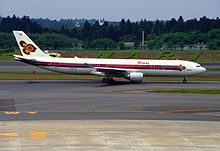Airbus Industrie Flight 129
1994 Aviation accident From Wikipedia, the free encyclopedia
1994 Aviation accident From Wikipedia, the free encyclopedia
Airbus Industrie Flight 129 was an Airbus Industrie A330-321 test flight that ended in a crash on 30 June 1994 at Toulouse–Blagnac Airport, killing all seven people aboard. The last test flown was to certify the plane's takeoff capability with a single engine failure.[1] It was the first fatal accident involving an Airbus A330 as well as the first hull loss of the type.[3] It remained the only fatal accident involving an A330 until the crash of Air France Flight 447 on 1 June 2009.[3]
 Thai Airways International Airbus A330-300, similar to the one involved in the accident | |
| Accident | |
|---|---|
| Date | 30 June 1994 |
| Summary | Pilot error leading to loss of control[1] |
| Site | Toulouse–Blagnac Airport 43°38′6″N 1°21′30″E |
| Aircraft | |
| Aircraft type | Airbus A330-321 |
| Operator | Airbus Industrie |
| Call sign | WHISKEY WHISKEY KILO HOTEL[2] |
| Registration | F-WWKH |
| Flight origin | Toulouse–Blagnac Airport |
| Destination | Toulouse–Blagnac Airport |
| Occupants | 7 |
| Passengers | 4 |
| Crew | 3 |
| Fatalities | 7 |
| Survivors | 0 |
The aircraft involved in the accident was an Airbus A330-321, registration F-WWKH, c/n 42. Equipped with twin Pratt & Whitney PW4164 powerplants, it first flew on 14 October 1993.[4] The aircraft was 259 days old at the time of the accident. The aircraft belonged to Thai Airways International and was being flight-tested under agreement with the owner. Airbus Industrie already owed Thai Airways compensation for the hull loss of another plane it had damaged during testing in December 1993.[5]
The objective of the flight was to test the performance of the aircraft in simulated engine failures after takeoff, which meant throttling down one of the aircraft's engines to idle and switching off a hydraulic circuit.[6] During most of the tests, the aircraft's autopilot would be set to fly the plane to an altitude of 2,000 feet (610 m).[6] The particular test that led to the crash flew in a configuration with the plane's center of gravity near its aft limit, achieved by carrying tons of water in bladders in the rear of the aircraft's cabin.[7]
The captain was Airbus chief test pilot Nick Warner. The co-pilot was Michel Cais, an Air Inter training captain who had been working with the Airbus training organization Aeroformation. A flight test engineer, Jean-Pierre Petit, was on board as the third member of the crew.[8][9]
Airbus management was interested in promoting the plane to potential customers, and did not perceive the test to be hazardous, so they invited four passengers on the plane: two Airbus executives (Philippe Tournoux and Keith Hulse), and two Alitalia pilots, Alberto Nassetti and Pier Paolo Racchetti, who were in Toulouse for a commercial training programme at the Airbus headquarters.[10][9]
The aircraft had just successfully completed a landing, after the captain had performed two simulated engine loss go-arounds, taking a total of 55 minutes. The second takeoff would be made with the aircraft's center of gravity located in an extreme aft position.[8] This time the aircraft was flown by the co-pilot, while the actions to shut off the engine and hydraulic circuit, and engage the autopilot, were carried out by the captain.[8][11] The takeoff was completed successfully and the captain shut off the engine and hydraulic circuit. Three attempts were needed to engage the autopilot[11] and the aircraft started to ascend to 2,000 feet (610 m). The aircraft climbed too steeply, decreasing airspeed to 100 knots (120 mph; 190 km/h), below the minimum 118 knots required to maintain control.[11] The aircraft started to roll, so the crew reduced power on the operating engine to counter the thrust asymmetry. This exacerbated the problem and the aircraft pitched down 15 degrees and soon after crashed into the ground. All seven people on board were killed, and the aircraft was destroyed.[1]
The crash was investigated by a commission of enquiry within the Direction Générale de l'Armement (DGA), the French Government Defense procurement and technology agency responsible for investigating flight test accidents. The commission found the crash was due to "a combination of several factors, no one of which, in isolation, would have caused the crash."[8] These included:[8]
Seamless Wikipedia browsing. On steroids.
Every time you click a link to Wikipedia, Wiktionary or Wikiquote in your browser's search results, it will show the modern Wikiwand interface.
Wikiwand extension is a five stars, simple, with minimum permission required to keep your browsing private, safe and transparent.